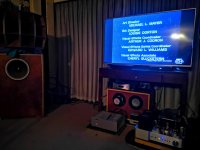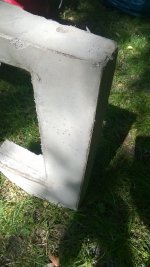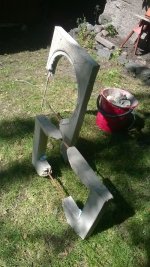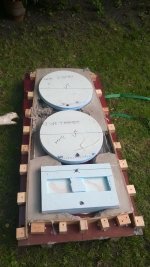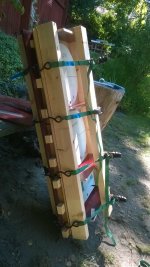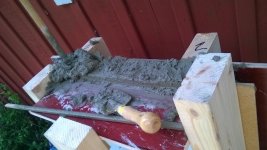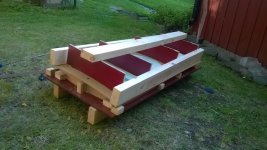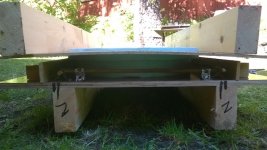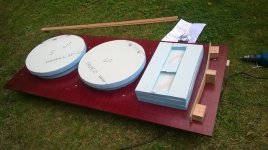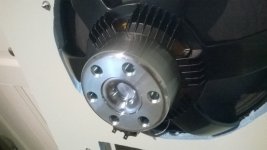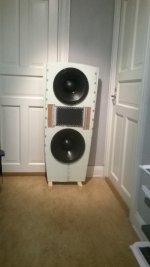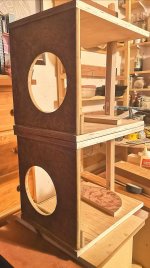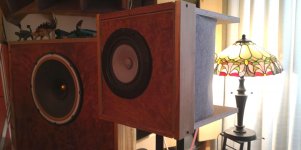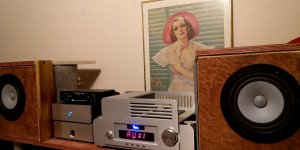I understand the discussion is about open baffle and not necessarily dipoles exactly, but I'm wondering if using felt effects the radiation reaching the baffle edge such that the cancellation is compromised?
Felt is a great baffle material. I documented some experiments with it in a thread a while ago.
The best thing about them is that the felt doesn't even need to be thick (I used 3 layers in that thread but a single layer is enough, even down to 100 hz). The sound wants to take the path of least resistance and even a single layer of felt present more resistance than free air and a bit more distance. In fact I got worse results when I used too much felt. Too much in this example was a monstrosity with where I glued 20 cm of felt glued together and carved it into a donut shape. Sadly I never photographed that monstrosity, it was vanquished shortly after I measured and saw how horrible it was.
Gotcha. Thanks.
I understand the discussion is about open baffle and not necessarily dipoles exactly, but I'm wondering if using felt effects the radiation reaching the baffle edge such that the cancellation is compromised?
I made a lot of measurements when I added the felt to the baffle. I also tried a few different adaptations of the felt and found full cover on my speakers made the biggest difference.
From the measurements I made I came to the conclusion the felt dealt with 2 sources of colouration.
The first - baffle is quite large compared to the cone and using an accelerometer to measure the vibration on the baffle the felt reduces these vibrations significantly.
Second is the wave emanating from the baffle edge. I placed the mic at different angles around the baffle edge, there was a reduction in amplitude around the edge.
I made a lot of measurements when I added the felt to the baffle. I also tried a few different adaptations of the felt and found full cover on my speakers made the biggest difference.
From the measurements I made I came to the conclusion the felt dealt with 2 sources of colouration.
The first - baffle is quite large compared to the cone and using an accelerometer to measure the vibration on the baffle the felt reduces these vibrations significantly.
Second is the wave emanating from the baffle edge. I placed the mic at different angles around the baffle edge, there was a reduction in amplitude around the edge.
I have ordered some large 4mm felt sheets for an unboxed cabinet experiment.
The plan is to make a simple u shaped frame, with the front acting as a baffle, and the other parts as the top and bottom of the unbox.
The sides and rear of the unbox will be the felt.
I'm guessing it will damp the rear wave, without reflecting anything to the back of the driver, in this case, my Alpair 12P pair.
I'm hoping it'll act as an aperiodic vent system, while still allowing plenty of ambience all around.
I also think it's worth cutting nearly full length slots around all four sides of the front, parallel with the baffle. It's my thinking this will be the easiest path for the out of phase backwave to escape.
Maybe this will provide enough edge cancellation to provide mini monitor like imaging: it will effectively isolate the front baffle from its surroundings. Hopefully.
Got the idea from another poster's idea of putting a reflecting panel behind his open baffle main driver, to limit front wall reflections.
Plus the recent benefits of felt discussed here.
Images to follow sawdust.
This seems less fussy than my original idea: same frame, but wrapped in grill cloth, then experiments with the degree of stuffing for damping.
Thank you for the link to that thread. I saw it some time ago but forgot what it was called. I shall enjoy reading itFelt is a great baffle material. I documented some experiments with it in a thread a while ago.
The best thing about them is that the felt doesn't even need to be thick (I used 3 layers in that thread but a single layer is enough, even down to 100 hz). The sound wants to take the path of least resistance and even a single layer of felt present more resistance than free air and a bit more distance. In fact I got worse results when I used too much felt. Too much in this example was a monstrosity with where I glued 20 cm of felt glued together and carved it into a donut shape. Sadly I never photographed that monstrosity, it was vanquished shortly after I measured and saw how horrible it was.
I got a big clarity improvement by taking warrjon’s felt baffle idea to heart.
I mounted the driver through the first layer of felt tight to the baffle, and then secured a second layer separated 1/4” from the first that wraps around to the rear of the baffle, such that the baffle edges are rounded felt.
That, and a 10 degree backward tilt on the fullrange make it almost ok without equalization. The tilt also makes the freq response as you move side to side vary much less than it used to. Image isn’t just clearer, it’s more stable vs listening position.
Most but not all of the harshness I perceived has gone with these changes, very happy with it.
I mounted the driver through the first layer of felt tight to the baffle, and then secured a second layer separated 1/4” from the first that wraps around to the rear of the baffle, such that the baffle edges are rounded felt.
That, and a 10 degree backward tilt on the fullrange make it almost ok without equalization. The tilt also makes the freq response as you move side to side vary much less than it used to. Image isn’t just clearer, it’s more stable vs listening position.
Most but not all of the harshness I perceived has gone with these changes, very happy with it.
Finally set for surround
Open baffle full range + horns as helpers for L/R, MarkAudio dual 12PW as centre U Frame.
There's enough resonance there to knock the bass down 6db to maintain normal balance in sound, so that's a little extra free headroom for my little amp, on the left. The other little amp on the right powers the horn hybrids.
The centre channel's twin does the rear surrounds, with each driver separately amplified.
My first open baffle/ open back surround sound system, and I think it rocks!
My first all class A amplified surround sound system ,too.
Open baffle full range + horns as helpers for L/R, MarkAudio dual 12PW as centre U Frame.
There's enough resonance there to knock the bass down 6db to maintain normal balance in sound, so that's a little extra free headroom for my little amp, on the left. The other little amp on the right powers the horn hybrids.
The centre channel's twin does the rear surrounds, with each driver separately amplified.
My first open baffle/ open back surround sound system, and I think it rocks!
My first all class A amplified surround sound system ,too.
Attachments
I have ordered some large 4mm felt sheets for an unboxed cabinet experiment.
Maybe this will provide enough edge cancellation to provide mini monitor like imaging: it will effectively isolate the front baffle from its surroundings.
Let us know how it goes.
My speakers with the 12P's magnet mounted with a 400mm wide MDF plywood sandwich even without the felt image superbly. In fact with closed eyes it is impossible to locate the speakers. I found the felt improved detail.
For inspiration :-D
First some prototyping with light and soft material - some re-thinking, then going for gold, but, eventually fail.
Midrange (400Hz ->) is/was a Göbeln inspired carbon bending wave transducer.
Why didnt I do an "open back" mold? Stupid!! (I think I wanted smooth surface on both sides really)
No retry - yet
//
First some prototyping with light and soft material - some re-thinking, then going for gold, but, eventually fail.
Midrange (400Hz ->) is/was a Göbeln inspired carbon bending wave transducer.
Why didnt I do an "open back" mold? Stupid!! (I think I wanted smooth surface on both sides really)
No retry - yet
//
Attachments
Last edited:
Let us know how it goes.
My speakers with the 12P's magnet mounted with a 400mm wide MDF plywood sandwich even without the felt image superbly. In fact with closed eyes it is impossible to locate the speakers. I found the felt improved detail.
I misjudged the dimensions I was after prior to ordering. My unenclosure will have non resonant Felt sides and a rounded back of 4mm grey felt, but will start with a recycled veneered baffle.
I guess really, it's like a u frame, sort of, with constant aperiodic venting.
Or a folded baffle with air resistance.
Finishing glue up.tonight, then will felt it up tomorrow, temporal tenses notwithstanding.
Attachments
… it's like a u frame, sort of, with constant aperiodic venting...
I guess you will have to use many 4mm layers to get any significant aperiodic loading, and that th elayers increasingly ethe effect moves lower in frequency.
dave
I guess you will have to use many 4mm layers to get any significant aperiodic loading, and that th elayers increasingly ethe effect moves lower in frequency.
dave
I can't venture an adequate guess.
I'm almost pleased with the 12P on an open baffle plus subwoofer.
Mostly I'm hoping this will lower the lower limit of the 12P while still avoiding box resonances.
Instead of more layers, which I hadn't thought of, I was considering experimenting with cotton or wool stuffing, if it goes sideways. Figuratively, because it literally will.
Let us know how it goes.
My speakers with the 12P's magnet mounted with a 400mm wide MDF plywood sandwich even without the felt image superbly. In fact with closed eyes it is impossible to locate the speakers. I found the felt improved detail.
It turned out much better sounding than I expected.
Seems to fall off @70 or 80 Hertz, and still has some of the backless cabinet ambience.
I still prefer the sound of the 12PW drivers in
U-Frames over these, but it's a difficult choice now.
Attachments
Very interesting, did you try them?
Best Regards
Sorry for ask to much in a gallery thread, I ask about if you listen some of their materialHe designed them if I’m not wrong
Phasey
Using the uncabinets in my secondary system with an old Polk sub, and a Miller Kreisel LP-1S passive highpass filter.
It's nearly as full in sound as with an actual cabinet, minus box resonances. However.
Something funny peculiar going on with the phase response of that felt lossy uncabinet I haven't encountered before.
For nearly all music, bass is integrated perfectly, but with some Steely Dan and Led Zeppelin songs, (not whole albums) the bass both detaches from the satellites, mutes itself slightly, and is clearly coming from the subwoofer.
Still, it's been an interesting experiment, and aside from those rare anomalies, it's very satisfying sound.
These have displaced my old favourites, Scanspeak Revelator woofers in sealed cabinets plus the tweeters du jour.
Anyone have any theories on what's going on with the bass phase?
Using the uncabinets in my secondary system with an old Polk sub, and a Miller Kreisel LP-1S passive highpass filter.
It's nearly as full in sound as with an actual cabinet, minus box resonances. However.
Something funny peculiar going on with the phase response of that felt lossy uncabinet I haven't encountered before.
For nearly all music, bass is integrated perfectly, but with some Steely Dan and Led Zeppelin songs, (not whole albums) the bass both detaches from the satellites, mutes itself slightly, and is clearly coming from the subwoofer.
Still, it's been an interesting experiment, and aside from those rare anomalies, it's very satisfying sound.
These have displaced my old favourites, Scanspeak Revelator woofers in sealed cabinets plus the tweeters du jour.
Anyone have any theories on what's going on with the bass phase?
Attachments
Not myself. But user Leonidas that you quoted and whom you asked your question is the Leon mentioned in the article.
I bet he has definetly heard those speakers
Yes I'm the designer. Leonidas is my audio design name.
Up to now there are only 2 sets to be heard : one at my place and the other set at Lii Audio , in China.
IMHO : the Liionidas OB is the best OB design I ever did.
Leon.
- Home
- Loudspeakers
- Multi-Way
- Ultimate Open Baffle Gallery
